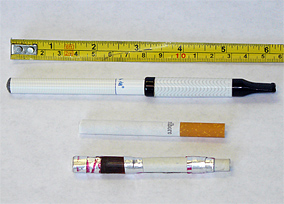Smokeless Cigarette Case Study
Smoking addiction has to do with the brain re-programming itself to supplement its chemistry with nicotine. It also has also to do with the habits and rituals involved with the consumer's handling and preparing of smoking articles. In smoker's doses, nicotine is addictive but not otherwise considered poisonous. GHT can take the toxins out of "smoking," including the carbon monoxide.
Before GHT:
In its manufacture, smoking tobacco is combined with chemical additives, ranging across a government-approved list of 599 compounds. When ignited, cigarettes release nicotine and more than 400 toxins (some carcinogens) into the the air. The nicotine and toxins are also directly inhaled by the smoker.
Today:
GHT can produce a smoking experience satisfying the consumer's addiction without the toxic combustion products of tobacco and its additives. GHT's heaters can volatilize a flavored nicotine mixture for inhalation without having burned it. In conventional burning cigarettes, GHT has technology to transform toxic carbon monoxide to carbon dioxide.
A sample of a Ruyan e-cigarette, ecigarettes.cn, is shown at left. It requires a battery in atomizing a flavored propylene glycol based nicotine solution to create an inhalable steam like vapor. Cartridges are an ongoing purchase item. The plug-in charger also must be purchased.
Tobacco industry tests have shown GHT's flameless catalytic heaters capable of providing proper temperature operation and steady heat applicable to substitution for burning cigarette materials. They can heat but not burn a tobacco product to provide the most accustomed flavor and realistic smoking experience without the smoking toxins. For pennies. Designable for single use, or as a reusable platform with miniature pop-in fuel cartridges.



